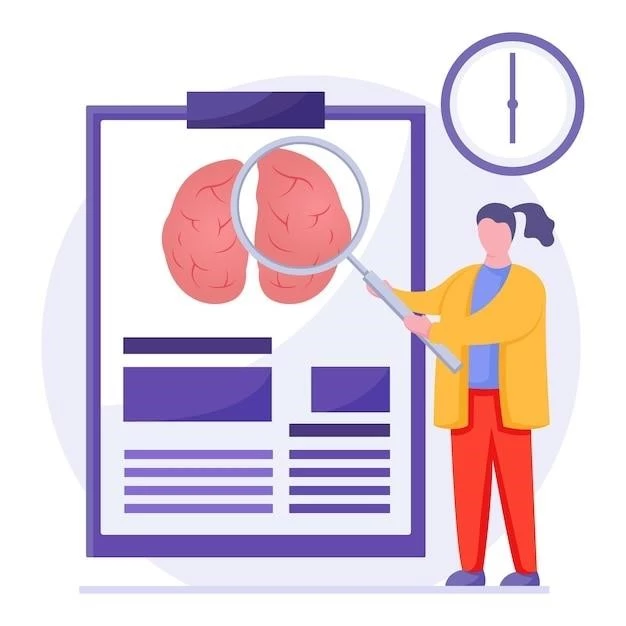Understanding Hyperadrenalism Disease
Hyperadrenalism‚ also known as Cushing’s syndrome‚ is a condition caused by excessive cortisol levels. Learn how the adrenal gland functions and the symptoms‚ diagnosis‚ and treatment options available.
I. Introduction to Hyperadrenalism
Hyperadrenalism‚ also known as Cushing’s syndrome‚ is a disorder characterized by the overproduction of cortisol by the adrenal glands. This excess cortisol can lead to a variety of symptoms and complications. Understanding the causes‚ symptoms‚ diagnosis‚ and treatment options for hyperadrenalism is crucial for managing the condition effectively. By learning more about hyperadrenalism‚ individuals can work closely with healthcare providers to develop a personalized treatment plan that addresses their specific needs. Educating oneself about hyperadrenalism empowers individuals to make informed decisions about their health and well-being. It is essential to seek medical advice promptly if experiencing symptoms suggestive of hyperadrenalism to receive timely diagnosis and appropriate care. With the right knowledge and support‚ individuals can effectively manage hyperadrenalism and improve their quality of life.
II. The Adrenal Gland and its Functions
The adrenal glands‚ located on top of each kidney‚ play a vital role in the body’s endocrine system. These glands produce hormones essential for regulating metabolism‚ immune response‚ blood pressure‚ and stress response. The two main hormones produced by the adrenal glands are cortisol and aldosterone. Cortisol helps the body respond to stress‚ regulate metabolism‚ and maintain blood pressure. Aldosterone controls the balance of water and electrolytes in the body. Understanding the functions of the adrenal glands is crucial as dysfunction can lead to conditions like hyperadrenalism‚ which affects the body’s hormone balance. By recognizing the importance of the adrenal glands and how they contribute to overall health‚ individuals can better comprehend the impact of hyperadrenalism on their well-being. Seeking medical advice for any symptoms of adrenal gland dysfunction is key to early diagnosis and effective management of related conditions. With a deeper understanding of the adrenal gland’s functions‚ individuals can take proactive steps to maintain hormonal balance and support overall health.
III. Symptoms of Hyperadrenalism
Hyperadrenalism‚ or Cushing’s syndrome‚ can manifest with a range of symptoms that impact physical appearance‚ metabolism‚ and emotional well-being. Common symptoms include weight gain‚ particularly in the upper body and face (moon face)‚ thinning skin that bruises easily‚ muscle weakness‚ fatigue‚ high blood pressure‚ and irregular menstrual cycles in women. Other signs may include mood changes‚ increased thirst‚ and frequent urination. Recognizing these symptoms is crucial for prompt diagnosis and treatment of hyperadrenalism. It is essential to seek medical advice if experiencing persistent or concerning symptoms associated with hyperadrenalism to prevent complications and improve quality of life. Consulting a healthcare provider for proper evaluation and management is key to addressing the symptoms of hyperadrenalism effectively. By understanding the signs and symptoms of this condition‚ individuals can take proactive steps to manage their health and well-being.
IV. Diagnosis of Hyperadrenalism
Diagnosing hyperadrenalism involves a comprehensive evaluation that includes medical history‚ physical examination‚ and laboratory tests. Healthcare providers may perform blood and urine tests to measure hormone levels‚ such as cortisol and ACTH. Imaging studies like CT scans or MRIs can help identify any abnormalities in the adrenal glands. Additional tests‚ such as the dexamethasone suppression test or the corticotropin-releasing hormone stimulation test‚ may be used to confirm the diagnosis. It is important to work closely with healthcare professionals to undergo the necessary tests and evaluations for an accurate diagnosis of hyperadrenalism. Seeking timely diagnosis is essential for initiating appropriate treatment and managing the condition effectively. By collaborating with healthcare providers and following their guidance‚ individuals can navigate the diagnostic process with confidence and gain a better understanding of their health condition.

V. Treatment Options for Hyperadrenalism
Treatment for hyperadrenalism aims to reduce cortisol levels and manage symptoms effectively. Depending on the underlying cause‚ treatment options may include medication‚ surgery‚ or a combination of both. Medications like ketoconazole‚ metyrapone‚ or mifepristone may be prescribed to inhibit cortisol production. In cases where a tumor is causing hyperadrenalism‚ surgery to remove the tumor from the adrenal or pituitary gland may be recommended. It is essential to discuss treatment options with healthcare providers to determine the most suitable approach based on individual needs and preferences. Regular follow-up appointments and monitoring are crucial to assess treatment effectiveness and make any necessary adjustments. By actively participating in the treatment process and maintaining open communication with healthcare professionals‚ individuals can work towards managing hyperadrenalism and improving their quality of life.
A. Medication for Hyperadrenalism
Medications play a key role in managing hyperadrenalism by targeting the excess production of cortisol. Common medications used in the treatment of hyperadrenalism include ketoconazole‚ metyrapone‚ and mifepristone. These medications work by inhibiting cortisol production or blocking its effects on the body. It is important to follow the prescribed dosage and schedule as directed by healthcare providers to ensure optimal treatment outcomes. Regular monitoring of hormone levels and potential side effects is essential when taking medications for hyperadrenalism. Communicating any concerns or changes in symptoms to healthcare professionals is crucial for adjusting treatment as needed. By staying informed about medication options‚ individuals can actively participate in their treatment plan and effectively manage hyperadrenalism with the guidance of healthcare providers.
B. Surgical Interventions for Hyperadrenalism
Surgical interventions may be necessary in cases where hyperadrenalism is caused by a tumor in the adrenal or pituitary gland. The primary goal of surgery is to remove the tumor responsible for the excess production of cortisol. Adrenalectomy‚ the surgical removal of one or both adrenal glands‚ may be performed to address adrenal tumors. Pituitary surgery may be recommended for tumors affecting the pituitary gland. It is important to discuss the risks‚ benefits‚ and expected outcomes of surgical interventions with healthcare providers. Following surgery‚ close monitoring and regular follow-up appointments are essential to assess recovery and hormone levels. Adhering to post-operative care instructions and attending scheduled appointments can help optimize surgical outcomes and support long-term management of hyperadrenalism. By preparing for surgery and collaborating with healthcare professionals‚ individuals can navigate the surgical treatment process with confidence and achieve the best possible results.
VI. Hormones Involved in Hyperadrenalism
Hyperadrenalism‚ or Cushing’s syndrome‚ involves dysregulation of hormones like cortisol and aldosterone. Cortisol plays a crucial role in stress response‚ metabolism‚ and immune function. Excess cortisol in hyperadrenalism can lead to various symptoms. Aldosterone‚ responsible for water and electrolyte balance‚ can also be affected in some cases of hyperadrenalism. Understanding the role of these hormones is essential in recognizing and managing hyperadrenalism. By learning about the hormonal imbalances associated with hyperadrenalism‚ individuals can better comprehend their condition and work with healthcare providers to develop a tailored treatment plan. Monitoring hormone levels and discussing any concerns with healthcare professionals is important for effective management of hyperadrenalism. With a deeper understanding of cortisol and aldosterone’s impact on the body‚ individuals can actively participate in their treatment journey and strive for improved health outcomes.
A. Cortisol and its Role
Cortisol‚ known as the ″stress hormone‚″ plays a vital role in the body’s response to stress‚ regulation of metabolism‚ immune function‚ and blood pressure. In hyperadrenalism‚ excessive cortisol levels can lead to a range of symptoms and complications. Understanding the impact of cortisol dysregulation is crucial for managing hyperadrenalism effectively. By recognizing the role of cortisol in the body and its effects when imbalanced‚ individuals can work closely with healthcare providers to develop personalized treatment plans. Monitoring cortisol levels through tests and discussing symptoms with healthcare professionals is essential for ongoing management. By staying informed about cortisol and its functions‚ individuals can take proactive steps to address hyperadrenalism and improve their overall well-being.
B. Aldosterone and its Impact
Aldosterone‚ a hormone produced by the adrenal glands‚ plays a crucial role in regulating water and electrolyte balance in the body. In hyperadrenalism‚ aldosterone levels may be affected‚ leading to disturbances in fluid balance and blood pressure regulation. Understanding the impact of aldosterone dysregulation is essential in managing hyperadrenalism effectively. By recognizing the role of aldosterone in maintaining fluid and electrolyte balance‚ individuals can work with healthcare providers to address related symptoms and complications. Monitoring aldosterone levels through tests and discussing any concerns with healthcare professionals is key to managing hyperadrenalism; By staying informed about aldosterone and its functions‚ individuals can take proactive steps to support their overall health and well-being while navigating the challenges of hyperadrenalism.
VII. Differences Between Cushing’s Syndrome and Addison’s Disease
It is important to differentiate between Cushing’s syndrome and Addison’s disease‚ two distinct conditions involving the adrenal glands. Cushing’s syndrome is characterized by excessive cortisol levels‚ leading to symptoms like weight gain‚ high blood pressure‚ and muscle weakness. On the other hand‚ Addison’s disease results from adrenal insufficiency‚ causing low levels of cortisol and aldosterone. Symptoms of Addison’s disease include fatigue‚ weight loss‚ low blood pressure‚ and skin discoloration. Understanding these differences is crucial for accurate diagnosis and appropriate treatment. Healthcare providers can perform tests to determine cortisol and aldosterone levels‚ helping differentiate between the two conditions. By recognizing the specific symptoms and hormonal imbalances associated with each condition‚ individuals can work collaboratively with healthcare professionals to manage Cushing’s syndrome or Addison’s disease effectively and improve their quality of life.
VIII. Understanding Adrenal Insufficiency
Adrenal insufficiency‚ such as Addison’s disease‚ occurs when the adrenal glands do not produce enough cortisol and aldosterone. This can result in symptoms like fatigue‚ weight loss‚ low blood pressure‚ and electrolyte imbalances. Understanding adrenal insufficiency is essential for timely diagnosis and proper management. Healthcare providers may perform tests to assess hormone levels and adrenal function to confirm the diagnosis. Treatment for adrenal insufficiency typically involves hormone replacement therapy to restore cortisol and aldosterone levels. It is important to follow the prescribed treatment plan and attend regular follow-up appointments to monitor hormone levels and adjust medication as needed. By educating oneself about adrenal insufficiency‚ individuals can actively participate in their care and work towards improving symptoms and overall well-being with the guidance of healthcare professionals.
IX. Recognizing and Managing Adrenal Crisis
Adrenal crisis is a life-threatening situation that can occur in individuals with adrenal insufficiency‚ such as Addison’s disease‚ when cortisol levels drop significantly. Recognizing the signs of adrenal crisis‚ including severe weakness‚ confusion‚ low blood pressure‚ and vomiting‚ is crucial for immediate intervention. In case of suspected adrenal crisis‚ it is important to seek emergency medical assistance promptly. Managing adrenal crisis involves administration of intravenous fluids‚ steroids‚ and close monitoring in a hospital setting. Individuals with adrenal insufficiency should carry an emergency kit containing injectable steroids for use in adrenal crisis situations. Understanding the importance of prompt action and having a clear plan in place can help save lives during adrenal crisis. By staying informed about adrenal crisis symptoms and preparedness measures‚ individuals and caregivers can effectively navigate emergency situations and ensure timely intervention for adrenal insufficiency.
